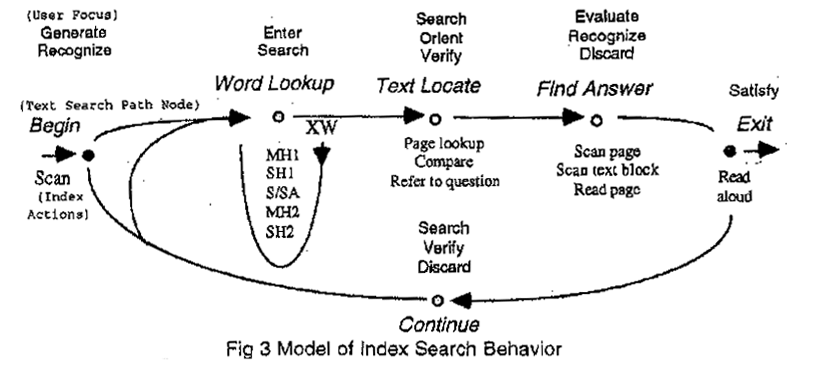Modelling information seeking behaviours in index use (Liddy & Jorgensen, 1993)
Citation - Liddy, E. D., & Jorgensen, C. (1993). Modelling information seeking behaviours in index use. In Proceedings of the 56th annual meeting of the american society for information science, (pp. 185-190). Medford, New Jersey: Learned Information, Inc.
Keyword - index, indexing, information behavior, back-of-the-book index
(background and methodology, see Jorgensen, C. & Liddy, E. D. (1994). An analysis of information seeking behaviors in index use, or opening Pandora's box. Proceedings of the 15th National Online Meeting.)
Results
“A preliminary model of searching in a back-of-the-book index was derived from an analysis of a subset of the data described above, records for the Basic Index and three variations (No see/see also references, a split index, and an index with few concept words). These three indexes were chosen because they represented three quite different index 'conditions' from the Basic index, which could possibly necessitate different search strategies. By working with data from a variety of index conditions and questions we believe that a generalizable model of index search behavior will emerge.”
透過基本索引與三種不同索引設計的搜尋行為,推導出一普遍的索引使用行為模型。
Model generation took place on three levels: 三種層次的模型概化
- Index Action: 索引使用行動層次。最具體層次的實體活動,是各種搜尋策略所能被觀察到的部份。
- Text Search Path: 關於文字範圍的檢索行為程序,可概化到各種文字的檢索(資料庫、全文)中
- Focus: 使用者在搜尋行為程序中,因為各程序中不同的資訊需求而導致的焦點轉換。
- 檢索者在書後索引使用中,主要有兩種層次的資訊需求:運用各種智慧策略以進行索引使用行動的需求;使用更普遍性本質的問題解決技巧時 對焦點轉換的需求(need to change focus while engaging in problem-solving techniques of a more general nature).
Index Actions
“Sixty searches (representing thirty subjects) were analyzed to identify a number of index actions.”
- Generate word to look up | 產生檢索目標詞彙
- Look up word in main heading | 在主標目中尋找字詞
- Look up word in subheading | 在次標目中尋找字詞
- Page locate | 標定頁碼
- Compare page numbers | 比較頁碼
- Scan page | 掃描頁面內容
- Mark place in text | 找出相關內容
- Compare headings | 比較標目與內容
檢索活動會繪製(Charted)次序,以從中發現模式或檢索策略。
Text search path
“From this set of charts a text-oriented model emerged, which involves direct interaction with a textual unit.”
由以上的活動次序,找出一以文字單位互動為主的文本導向模式。(p.186)
文字檢索路徑模型是一個有起始點與結束點的封閉循環,其中有以下元件:
- Begin | 起始點
最開始,檢索者需要先「理解」問題[3],並需要產生檢索字詞。與此相關的索引使用活動有:掃描(略讀)索引或目次(scanning the index or table of contents)、參考問題內的字詞(referring to the words in the question)、自我產生檢索詞彙(self-generation of terms)[4]。 - Word Lookup | 尋找字詞
尋找索引中的字詞,並經常橫跨索引中不同階層的字詞(主標目、次標目、等等),或沿著見/參見往另一個標目找去。如果在過程中找不到一詞彙,檢索者會選定另一詞彙重新開始尋找。 - Text Locate | 標定文字
尋找頁面。與此相關的索引使用活動有:標定頁碼(page number location)、比較標目頁碼與字詞(comparisons of headings, page numbers, and words)。 - Find Answer | 發現解答
找到頁面後的精讀(peruse)與略讀(scan)行為。略讀的範圍可能是一頁、一圖表、連續數頁、一整個章節等。檢索者隨後可能滿意此結果就此回答問題,而進入最後一個階段離開(Exit)此一檢索循環。 - Continue | 繼續尋找
當檢索者不滿意前述的結果,可繼續另一個尋找字詞(Word Lookup)循環、或另一個起始點(重新理解問題)。 - Exit | 結束點
User focus
新興的使用者研究關注於資訊需求與資訊行為的關係,因此本研究將索引使用的的檢索行為研究擴展到使用者動態地、改變其活動與程序的「焦點(Focus)」上。這些「焦點」與不同的資訊需求有關。
“To accomplish this goal, a higher-level set of user needs were identified, revealing a new level of complexity in index search behavior.”
發現十種索引使用者的行為焦點狀況(conditions):
- Understand | 理解檢索問題
“the searcher's satisfaction with his/her internal understanding of the question which is necessary before initialing a search and the reorientation necessary as the understanding of the question changes, narrows, and broadens during traversal of the search path.”
索引檢索者再開始檢索前,對於檢索題目的內在理解。當在檢索過程中此一理解改變、縮小或擴張時,會重新改變檢索的方向。 - Enter | 開始
“the need to find a entrance into the knowledge structure represented by the index. It is distributed from Understand by the fact that it involves a need to match the understanding of the question with the structure of the information access tool. It frequently involves finding the appropriate level on which to enter an index.”
發現進入索引知識結構的需求。與「理解」不同,此一焦點狀況需要以資訊取用工具(索引)的結構理解查詢問題。這通常指要找到進入索引的適當層次。 - Rely | 憑藉
“the searcher's need to use the internal knowledge to move to the next action. 'Rely' may be of more importance in situations where a searcher is familiar with the book being searched, as some of our subjects were.”
索引檢索者以其內在知識進行下一步活動。對於熟悉這本書的索引檢索者而言,「憑藉」可能是更重要的一種狀況。 - Orient | 導向(?)
“the need to understand the relationships of text objects (headings, subheadings, paragraphs, sections) in the index or text, or to verity that certain parts of the text have already been searched.”
了解索引或內文中文字物件(標目、次標目、段落、章節)彼此關係,或檢驗那些文字部分是已經檢索過了的需求。 - Generate | 產生
“the need to generate search term.”
產生檢索詞彙的需求。可能發生在檢索的最初,或是稍後當索引檢索者需要確認其搜尋結果的完成度時。此一活動可能是從旁側面的,或以縮小或擴張檢索的形式。 - Search | 尋求
“the need to locate a word, phrase, or concept, either in the text or the index and seems to follow a pattern-matching process very closely. Subjects in many cases did not recognize pertinent information when it was presented in terms other those they were searching for. One frequently comment was that the searchers was waiting for the term to 'jump out' from the page. Search is not only a follow-up to word finding in the index, but occurred at other nodes of the search path as well.” - Evaluate | 評估
“the need to take a much closer look at the information found in order to either recognize it as being pertinent or to discard it.” - Recognize/Discard | 指認/揚棄
“decision points in the search path. Either a unit of text is recognized as being pertinent to the question being answered, or discarded.” - Verify | 檢驗
“the need to confirm that either the amount of information found is satisfactory or is correct, or, similarly, that the understanding of the text structure and relationships thus far perceived is correct.” - Satisfy | 滿足
“the need to be convinced that the search has been successful. A search can be terminate without this state being reached, for even if the searcher has found some information it may not be perceived as being the 'best' or most complete information to answer the question.”
三層次間的關係
| USER FOCUS | Generate; Understand | Rely; Search | Verify; Orient | Evaluate; Recognize | Satisfy; Discard | Discard; Satisfy |
| SEARCH PATH NODE | Begin | Word-Lookup | Text-Locate | Find-Answer | Exit | Continue |
| INDEX ACTION | Scan-Index; Generate-Word | Look-in-MH; Follow-see | Page-Lookup; Comparisons | Scan-Text; Read-Pages | Read-Text-Aloud | Return-to-Begin |
“Identification of these levels and their complex interrelationships suggests why so many systems created for information retrieval, whether a print back-of-the-book indexes or an electronic retrieval systems, may fail the user. The majority of the system's offer limited search features at different nodes in the Text Search Path, while the reality is that the user need to employ a full range of information seeking actions throughout their traversal of the Text Search Path.” (p.188)
Content
Note
Metadata
file link - Google Schloar, XXC

